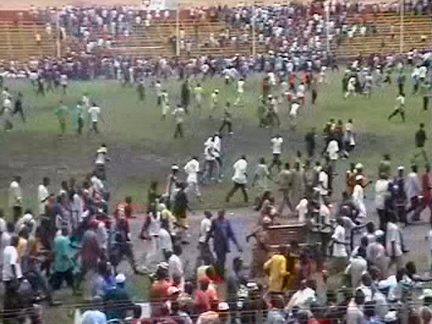Guinea - massacre
Killings and rapes were premeditated, says human rights group
Article published on the 2009-10-27 Latest update 2009-10-27 19:46 TU
Human Rights Watch released the findings of their 10-day investigation on Tuesday, the same day that the European Union placed an arms embargo and sanctions on the leaders of the country’s military junta.
Human rights groups say more than 150 people were killed and over 1,200 were injured when soldiers opened fire on protestors who were urging junta leader Captain Moussa Dadis Camara not to stand in presidential elections.
In graphic research results published on Tuesday, Human Rights Watch said that the massacre and widespread sexual violence that followed were organized and carried out largely by the Presidential Guard, who are commonly known as the “red berets”.
“We found that there was a pre-planned operation in which the military arrived in several trucks,” Corinne Dufka, a researcher at Human Rights Watch in Dakar, Senegal, told RFI. “There was tear gas fired and then they stormed the entrance to the stadium and began immediately firing their rifles directly into the crowd – killing tens of protestors in the process.
Interview: Corinne Dufka, Human Rights Watch
“They then surrounded the stadium apparently blocking most of the entrances. Individuals who were able to scale the walls and escape the actual stadium itself were then murdered in the very large compound area of the stadium.
“The sexual violence appeared to break out in numerous different places both within the stadium itself and then also the stadium compound at just about the same time. This is curious because in previous incidents of excessive use of force against large groups of demonstrators, there has never been sexual abuse that took place in the open.
“The fact that it broke out at the same time, that there were simultaneous attacks against girls and women in the stadium and on the compound, suggests that there was at least explicit permission given for this to carry on.”
Dufka said that Human Rights Watch initially thought that about 30 women were subjected to acts of sexual violence, but having personally interviewed 26 victims, she fears the figure could be much higher.
“The majority of them were gang-raped – that is raped by more than one individual. The typical story was that after the shooting started at the stadium, they tried to get away. They were then attacked by groups of between two and four or five red berets. They were pushed to the ground and then a few of them held the woman while the first one raped her and the others subsequently raped her.”
She said they had gathered testimony that other women were gang-raped over three to five days.
“These women and indeed other victims saw the murder of several women who were shot in the vagina after they were raped, bayoneted in the vagina or shot as they were trying to get away. So this was extremely brutal and cruel sexual violations that these women were subjected to.”
While a number of victims reported that some individual police officers tried to help, according to Dufka none of those in charge tried to stop the attackers.
“We spoke with direct witnesses who described the commanders apparently in charge of the operation walking by as there were numerous rapes in progress. So they made absolutely no effort to stop the rape in progress.”
The Guinean leader has said he was not responsible for the massacre, but Dufka says the evidence Human Rights Watch has gathered has left her in no doubt that it was a planned operation.
“While there may be uncontrolled, undisciplined elements within the Guinean military, the individuals who carried out this massacre and the widespread sexual abuse were not undisciplined elements. They were members of the Presidential Guard, commanded by individuals who are directly under Dadis’s control – that is his aide-de-camp and officers that work very closely with him.”
The United Nations has launched a probe into the massacre.










